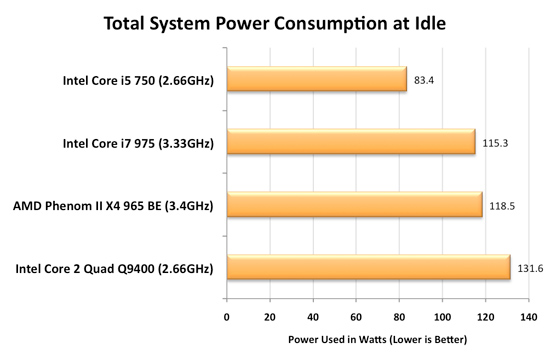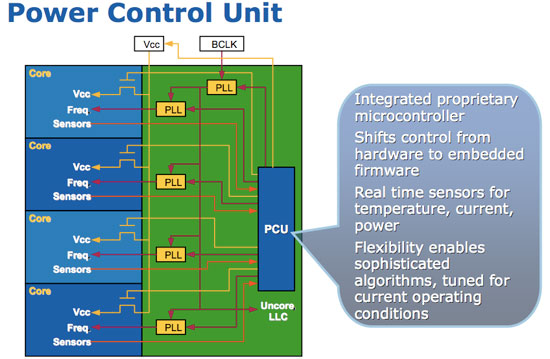Intel's Core i7 870 & i5 750, Lynnfield: Harder, Better, Faster Stronger
by Anand Lal Shimpi on September 8, 2009 12:00 AM EST- Posted in
- CPUs
Homework: How Turbo Mode Works
AMD and Intel both figured out the practical maximum power consumption of a desktop CPU. Intel actually discovered it first, through trial and error, in the Prescott days. At the high end that's around 130W, for the upper mainstream market that's 95W. That's why all high end CPUs ship with 120 - 140W TDPs.
Regardless of whether you have one, two, four, six or eight cores - the entire chip has to fit within that power envelope. A single core 95W chip gets to have a one core eating up all of that power budget. This is where we get very high clock speed single core CPUs from. A 95W dual core processor means that individually the cores have to use less than the single 95W processor, so tradeoffs are made: each core runs at a lower clock speed. A 95W quad core processor requires that each core uses less power than both a single or dual core 95W processor, resulting in more tradeoffs. Each core runs at a lower clock speed than the 95W dual core processor.
The diagram below helps illustrate this:
| Single Core | Dual Core | Quad Core | Hex Core | |
| TDP |  |  |  |  |
| Tradeoff |  |  |  |  |
The TDP is constant, you can't ramp power indefinitely - you eventually run into cooling and thermal density issues. The variables are core count and clock speed (at least today), if you increase one, you have to decrease the other.
Here's the problem: what happens if you're not using all four cores of the 95W quad core processor? You're only consuming a fraction of the 95W TDP because parts of the chip are idle, but your chip ends up being slower than a 95W dual core processor since its clocked lower. The consumer has to thus choose if they should buy a faster dual core or a slower quad core processor.
A smart processor would realize that its cores aren't frequency limited, just TDP limited. Furthermore, if half the chip is idle then the active cores could theoretically run faster.
That smart processor is Lynnfield.
Intel made a very important announcement when Nehalem launched last year. Everyone focused on cache sizes, performance or memory latency, but the most important part of Nehalem was far more subtle: the Power Gate Transistor.
Transistors are supposed to act as light switches - allowing current to flow when they're on, and stopping the flow when they're off. One side effect of constantly reducing transistor feature size and increasing performance is that current continues to flow even when the transistor is switched off. It's called leakage current, and when you've got a few hundred million transistors that are supposed to be off but are still using current, power efficiency suffers. You can reduce leakage current, but you also impact performance when doing so; the processes with the lowest leakage, can't scale as high in clock speed.
Using some clever materials engineering Intel developed a very low resistance, low leakage, transistor that can effectively drop any circuits behind it to near-zero power consumption; a true off switch. This is the Power Gate Transistor.

On a quad-core Phenom II, if two cores are idle, blocks of transistors are placed in the off-state but they still consume power thanks to leakage current. On any Nehalem processor, if two cores are idle, the Power Gate transistors that feed the cores their supply current are turned off and thus the two cores are almost completely turned off - with extremely low leakage current. This is why nothing can touch Nehalem's idle power:

Since Nehalem can effectively turn off idle cores, it can free up some of that precious TDP we were talking about above. The next step then makes perfect sense. After turning off idle cores, let's boost the speed of active cores until we hit our TDP limit.

On every single Nehalem (Lynnfield included) lies around 1 million transistors (about the complexity of a 486) whose sole task is managing power. It turns cores off, underclocks them and is generally charged with the task of making sure that power usage is kept to a minimum. Lynnfield's PCU (Power Control Unit) is largely the same as what was in Bloomfield. The architecture remains the same, although it has a higher sampling rate for monitoring the state of all of the cores and demands on them.
The PCU is responsible for turbo mode.










343 Comments
View All Comments
snakeoil - Tuesday, September 8, 2009 - link
and the cherry on top of the piecore i5 750 and core i3 don't support virtualization.
http://www.virtualization.info/2009/07/intel-core-...">http://www.virtualization.info/2009/07/intel-core-......
that's fantastic, colossal intel.
what's wrong with intel
Anand Lal Shimpi - Tuesday, September 8, 2009 - link
Intel VT-x is supported by the Core i5 750:http://processorfinder.intel.com/details.aspx?sSpe...">http://processorfinder.intel.com/details.aspx?sSpe...
Take care,
Anand
snakeoil - Tuesday, September 8, 2009 - link
sorry incomplete linkhttp://www.virtualization.info/2009/07/intel-core-...">http://www.virtualization.info/2009/07/...core-i3-...
AssBall - Tuesday, September 8, 2009 - link
What are you talking about? These overclock FINE; read the article. 4 Ghz. Anyone that is gonna overclock bloomfield or lynnfield seriously is opting for an aftermarket HSF, so don't bother arguing that. Your comment doesn't make any sense.TA152H - Tuesday, September 8, 2009 - link
You missed the point.When you overclock the processors, you change the characteristics of turbo mode. Consequently, the big advantage of the Lynnfield disappears, and they run at the same clock speed, instead of the Lynnfield at a higher clock speed.
Do you understand now?
eternalfantasy - Tuesday, September 8, 2009 - link
lolemogoinginstyle - Tuesday, September 8, 2009 - link
"There are better sites that have answered these questions. I used to like this site, but this review is another disappointment. "Just how is that Tom's Hardware gig working out for you? I noticed your name was not on any of their launch reviews since you seem to be an expert on the subject. Why is that?
TA152H - Tuesday, September 8, 2009 - link
Thanks for asking.When I have time, I will be writing another article, which they hopefully will use, but to be honest, the time it takes to write an article, at least a well-written one, takes an enormous amount of time and effort.
Getting and verifying data is only part of it. Writing it in an artistic an interesting way is very time consuming, and, at least for me, requires many rewrites of the same pages. Each page took me at least five hours, some many more, plus the upfront time of deciding which pages to write, which probably took at least 30 hours of research.
The editor of Tom's wrote their articles, and it's clear to see the much more thorough review he did. Personally, I like him and occasionally do communicate with him, and I probably would like Anand too, since he seems like a good fellow, but I have no real affiliation with their site. If I write an article they like, they might publish it. That's it.
But, honestly, if you do it for money, you're a fool. It takes WAY too much time for that. You really have to want to do it, and the money is secondary.
goinginstyle - Tuesday, September 8, 2009 - link
So it took you five hours a page to do a copy and paste from Wikipedia on that so called article of yours? I read the Tom's P55 article, not seeing how it was any more thoughtful than the one here or at Tech Report. At least Anand did some searching and reported on items like PCIe clocking/voltage requirements that I noticed was not mentioned at Toms.Your only motive for these posts is to try and look impressive at Toms in hopes that they will publish another boring piece of dung from you. Otherwise, your complaints here are just as justified at Toms or TR, yet you are not posting at either site. That is why it is so obvious as to what you are up to with the flame bait comments.
TA152H - Tuesday, September 8, 2009 - link
I never even looked at Wikipedia, since I don't consider it a valid source of information.Why do you talk about things you don't know about. In fact, some people used Wikipedia to argue some points with me. I made a point never to look at those pages.
But again, what have you done with your, except produce carbon dioxide and speed up global warming? You seem pretty worthless to me.